Vertical Farming Market by Growth Mechanism (Hydroponics, Aeroponics, Aquaponics), Structure (Building-based and Shipping container-based), Crop Type, Offering (Lighting, Sensors, Climate Control, Software, Services) & Region - Global Forecast to 2028
[240 Pages Report] The vertical farming market is estimated to be USD 5.1 billion in 2023, and it is expected to reach USD 15.3 billion by 2028, growing at a CAGR of 24.7% from 2023 to 2028. Various factors are fueling the growth of the vertical farming market. One of the key drivers is the decreasing availability of land for agriculture, which is happening due to urbanization, deforestation, and climate change. This trend poses a challenge to traditional farming methods, but vertical farming offers a solution by utilizing space more efficiently to produce food.
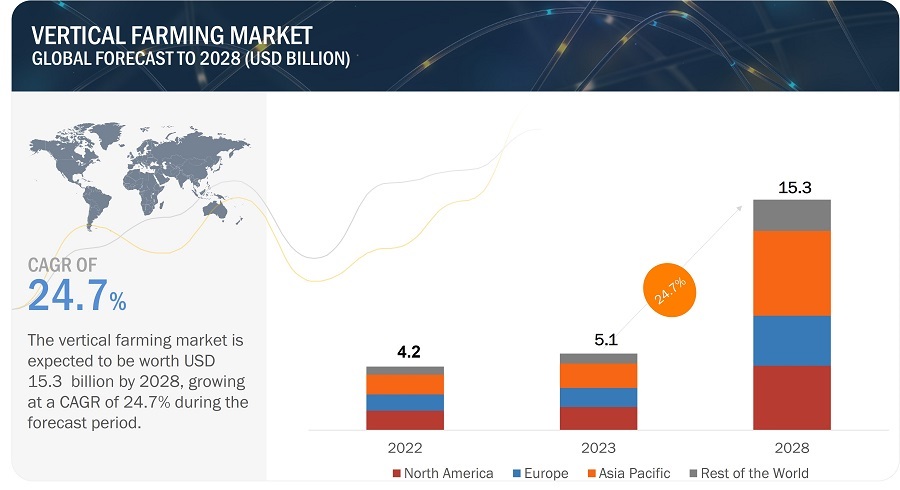
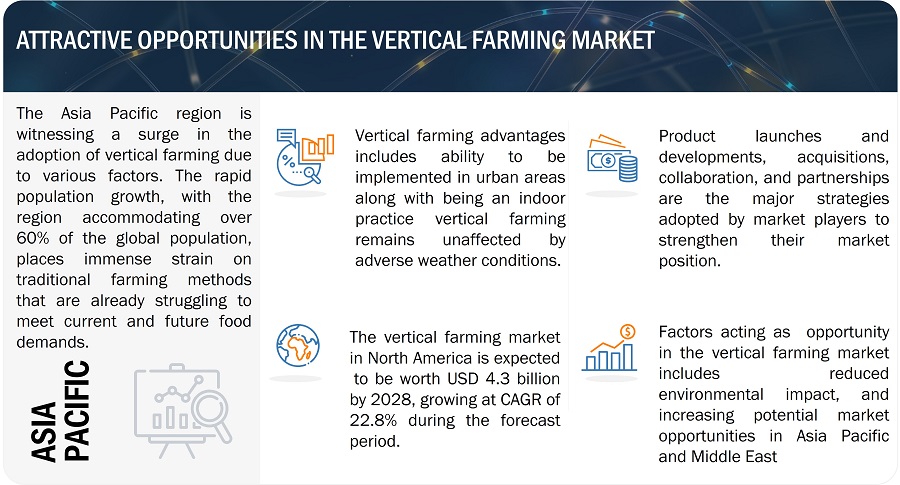
Vertical Farming Market Forecast to 2028
To know about the assumptions considered for the study, Request for Free Sample Report
Market Dynamics:
Driver: Reduced environmental impact from agriculture by the adoption of vertical farming
Vertical farming plays a vital role in reducing the environmental impact of agriculture. It reduces the water required to produce the same or higher number of crops. It also removes the chemicals and pesticides used to grow crops and diminishes the need for transportation. The entire process of vertical farming is carried out organically. It significantly eliminates the use of chemicals and provides natural solutions, such as using fish to produce nutrient-rich waste for plants in the aquaponics growth mechanism of vertical farming. Also, as vertical farming is carried out in a controlled environment, they are immune to dangerous pests, eliminating pesticide use. As methods of pest control such as burning fields, grass, or waste are omitted, vertical farming assures healthy, quality produce for its consumers. This, in turn, is expected to create growth opportunities for the players in the vertical farming market.
Restraint: Lack of technically skilled workforce and limited crop types
Vertical farming often involves use of technical solutions, such as cameras, sensors, automated systems, artificial intelligence, hydroponic, aquaponics, and aeroponic systems. To operate these advanced systems, a knowledgeable and skillful workforce is essential. The lack of a skilled workforce has affected different sectors globally, and vertical farming is no exception. Also, most farmers venture into this market with systems that are inefficient in terms of design and are costly. To sustain and remain competitive in the market, vertical farms need to be updated on different aspects of farming. Moreover, unlike conventional farming, growers can grow a limited range of crops in vertical farming, but these crops are economically and commercially viable today. Indoor farming is the future of farming but will not account for all growing operations; for instance, leafy greens are best grown in vertical farming, but tomatoes, cucumbers, and peppers are best grown in greenhouses.
Opportunity: Potential market opportunities in Asia Pacific and the Middle East
According to the Ministry of Agriculture, Forest, & Fisheries (MAFF), people in APAC consume about 75% of the vegetables produced globally. In APAC, most plant factories are in Japan, China, Hong Kong, and Singapore. Factors such as continuous growth in urban population, rising disposable income, and increasing middle-class population are expected to drive the demand for food and agricultural commodities and resources between 2023 and 2028. With the advantage of producing more in less area, vertical farming is being increasingly adopted in different countries in APAC. The Middle East is another market with high growth potential for vertical farming. The climate in Middle Eastern countries is hot for almost eight months a year, leaving a significantly less favorable period for crop production. This leads to the limited availability of local produce at high prices. However, countries such as the UAE and Israel are expected to hold high growth opportunities for the market.
Challenge: Higher energy consumption leads to high operational costs
Energy consumption and operating costs present significant restraints on the vertical farming market, impacting its scalability and economic viability. One area of concern is the energy-intensive nature of vertical farming, particularly the reliance on artificial lighting systems. Traditional lighting technologies, such as high-pressure sodium (HPS) lamps, consume substantial energy. A study by the University of California, Davis, found that HPS lighting alone accounted for 50% to 70% of the total energy consumption in a vertical farm. Furthermore, per the 2021 Global CEA Census Report, vertical farms demonstrate a considerably higher average energy consumption of 38.8 kWh per kilogram of produce. In contrast, traditional greenhouses have an average energy consumption of 5.4 kWh per kilogram.
Vertical Farming Market Ecosystem
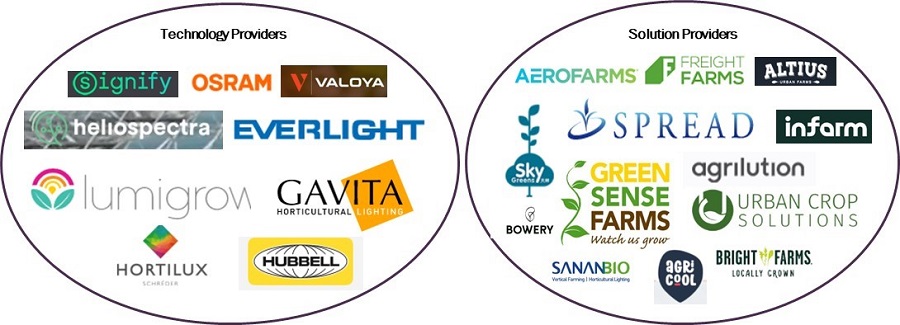
Lighting technology to dominate the overall hardware segment of the vertical farming market between 2023 and 2028
The adoption of LED lighting in vertical farms has significantly increased due to its numerous advantages catering to indoor agricultural environments’ specific needs. LED lights enable precise control over the light spectrum and intensity, allowing farmers to customize the lighting conditions to suit the requirements of different plants, resulting in optimal growth and higher yields. Furthermore, LED lights are highly energy-efficient, consuming considerably less electricity than traditional lighting sources. Their extended lifespan also reduces maintenance expenses. Additionally, LED lights emit less heat, minimizing the risk of heat-related damage to plants and creating a more favorable working environment for farmers. The versatility and benefits of LED lighting have made it a favored choice among vertical farm operators, playing a crucial role in the success and expansion of this innovative farming method.
Hydroponics technique is likely to be the most preferred vertical farming method among commercial growers during the forecast period
Hydroponics is a soil-less plant cultivation method that relies on water and nutrients, offering a highly efficient approach to growing food. It requires less space and water than conventional farming methods, making it a compelling choice. Furthermore, hydroponics enables year-round food production unaffected by weather conditions. Commercial growers find hydroponics particularly attractive due to its numerous benefits for vertical farming. Firstly, it ensures efficiency by reducing water usage and space requirements. Secondly, it grants growers more significant control over the growing environment within the hydroponic system. Thirdly, hydroponics consistently yields high-quality produce. Lastly, it promotes sustainability, providing a more environmentally friendly alternative to traditional farming practices. These advantages have positioned hydroponics as the preferred method for commercial growers engaging in vertical farming.
Building-based vertical farms likely to dominate the overall market between 2023 and 2028
For several compelling reasons, building-based vertical farm structures have emerged as dominant players in the overall vertical farming market. Firstly, their versatility allows them to be established in any location, irrespective of challenging climatic or weather conditions. This makes them particularly suitable for countries or regions facing difficulties in traditional farming due to factors like deserts or urban landscapes. Secondly, the efficiency of building-based vertical farms is notable, as they can maximize the utilization of resources such as water, space, and energy. By utilizing vertical stacking, these farms can produce a higher yield within a smaller area
US to dominate vertical farming market in North America as the country has the largest number of vertical farms in the region
The United States has emerged as the leading nation in North America, with the highest number of vertical farms, primarily due to its substantial population and the increasing demand for locally grown produce. With over 330 million people, the US provides a significant market for fresh agricultural products, driving the need for vertical farming solutions. Additionally, the country benefits from abundant capital resources, supported by a robust economy and a large pool of venture capital. This financial backing has facilitated the development and expansion of vertical farming companies. Moreover, the US enjoys a favorable regulatory environment that streamlines the establishment and operation of vertical farms, making it easier for companies to enter the market. Prominent examples of successful vertical farming companies in the US include AeroFarms, Bowery Farming, and Gotham Greens, operating farms in various cities across the country.
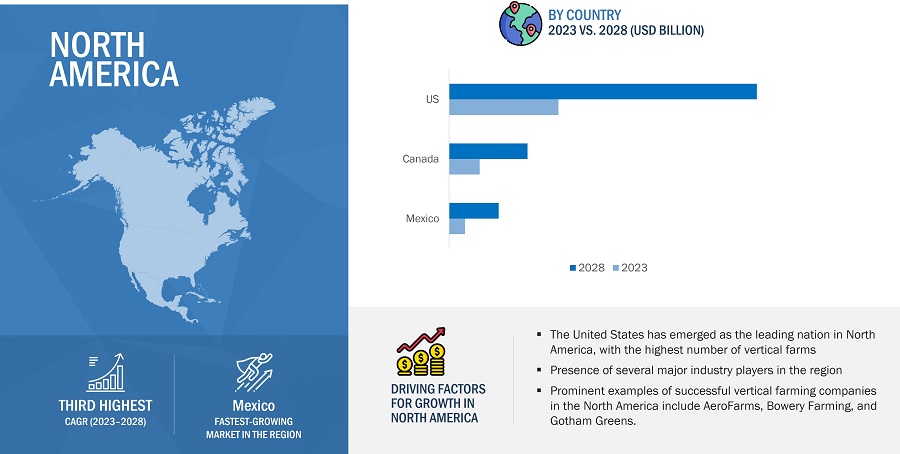
Vertical Farming Market by Region
To know about the assumptions considered for the study, download the pdf brochure
Key Market Players
Vertical Farming companies include Signify (Netherlands), Freight Farms (US), AeroFarms (US), Sky Greens (Singapore), Spread (Japan), Plenty (US), Valoya (Finland), Osram (Germany), Everlight Electronics (Taiwan), and Heliospectra AB (Sweden).
Get online access to the report on the World's First Market Intelligence Cloud
- Easy to Download Historical Data & Forecast Numbers
- Company Analysis Dashboard for high growth potential opportunities
- Research Analyst Access for customization & queries
- Competitor Analysis with Interactive dashboard
- Latest News, Updates & Trend analysis
Request Sample Scope of the Report
Get online access to the report on the World's First Market Intelligence Cloud
- Easy to Download Historical Data & Forecast Numbers
- Company Analysis Dashboard for high growth potential opportunities
- Research Analyst Access for customization & queries
- Competitor Analysis with Interactive dashboard
- Latest News, Updates & Trend analysis
|
Report Metric |
Details |
|
Market size available for years |
2019–2028 |
|
Base year considered |
2022 |
|
Forecast period |
2023–2028 |
|
Forecast units |
Value (USD), Market size indicated in USD million and billion. |
|
Segments covered |
Growth Mechanism, Structure, Crop Type, Offerings, and Region |
|
Regions covered |
North America, Europe, Asia Pacific, and RoW |
|
Companies covered |
Signify (Netherlands), ams-OSRAM AG (Germany), Freight Farms (US), AeroFarms (US), sky Greens (Singapore), Spread (Japan), Plenty (US), Valoya (Finland), Everlight Electronics (Taiwan), Heliospectra AB (Sweden), and Green Sense Farms (US). Total 25 companies covered
|
Vertical Farming Market Highlights
This research report categorizes the vertical farming market based on growth mechanism, structure, crop type, offerings and region.
|
Segment |
Subsegment |
|
By Growth Type |
|
|
By Structure |
|
|
By Crop Type |
|
|
By Offerings |
|
|
By Region |
|
Recent Developments
- In May 2023, AeroFarms revealed the expansion of its partnership with Amazon Fresh.
- In February 2023, ams OSRAM collaborated with Revolution Microelectronics, a US-based controlled agriculture environment designer.
- In February 2023, Realty Income, a commercial real estate investment trust, partnered with Plenty Unlimited Inc. The collaboration involves an investment of up to USD 1 billion to construct farming space that will be leased to Plenty Unlimited.
- In September 2022, Freight Farms collaborated with The University of Arizona Biosphere 2.
- In May 2022, Signify Holding, the global leader in lighting, successfully finalized the acquisition of Fluence from ams OSRAM.
- In May 2022, ams OSRAM introduced the OSLON Optimal family of LEDs, featuring the latest 1mm2 chip designed specifically for horticulture lighting applications.
- In August 2021, AeroFarms partnered with Nokia Bell Labs to combine their expertise and expand their joint capabilities in networking, autonomous systems, and integrated machine vision and machine learning technologies to identify and track plant interactions at the most advanced levels.
- In August 2021, AeroFarms announced that it would expand to the Middle West region as part of a project with the World Wildlife Fund (WWF) and St. Louis Controlled Environment Agriculture Coalition (STLCEA) to demonstrate innovative strategies to minimize the environmental footprint of indoor vertical farming.
- In July 2021, Heliospectra AB, a world leader in intelligent lighting technology for vertical farming, announced a new seller partnership with MineARC Systems, a global leader in manufacturing and supplying controlled environments. The company will represent Heliospectra’s market-leading LED lighting and lighting control solutions in the Australian market.
- In June 2021, Osram expanded its horticulture portfolio by launching Osconiq S 5050. It addresses a key problem of used white LEDs resulting in lower energy costs and more efficient lighting for indoor farmers.
Frequently Asked Questions (FAQ):
Who are the key players in the vertical farming market?
The company such as Signify (Netherlands), Osram (Germany), Valoya (Finland), AeroFarms (US), Plenty (US), and Sky Greens (Singapore) are key players in the vertical farming market. These players in this market have adopted various strategies to expand their global presence and increase their market shares. Acquisitions and product launches are among the important strategies adopted by market players.
What strategies are key companies adopting in the vertical farming market?
Some major strategies the key players adopt to grow in the vertical farming markets are product launches, partnerships, contracts, and M&A activities.
What are the key drivers of the vertical farming market?
Rising demand for fresh, local food, increasing focus on sustainability, declining arable land, and growing urban population are key drivers of vertical farming.
Which growth mechanism dominates the vertical farming market?
Hydroponics growth mechanism dominates the vertical farming market. Hydroponics is a popular choice in vertical farming because it offers several advantages over other techniques. For instance, it uses less water than aeroponics and aquaponics, making it highly water efficient.
How is competitive the landscape of the vertical farming Market?
The vertical farming market is highly competitive, with several large and small companies. The vertical farming market is still in its early stages of development, but it has the potential to revolutionize how we produce food. The market’s competitive landscape is expected to remain dynamic in the coming years as new companies enter the market and existing companies continue to innovate.
To speak to our analyst for a discussion on the above findings, click Speak to Analyst
Two basic sources of information-secondary and primary-have been used to identify and collect information for an extensive technical and commercial study of the vertical farming market. Secondary sources include company websites, magazines, industry news, associations, and databases (OneSource, Factiva, and Bloomberg). Primary sources mainly comprise several experts from the core and related industries, along with preferred component suppliers, lighting and sensors manufacturers, distributors, technology developers, system integrators, alliances, standards, and certification organizations related to various segments of this industry’s value chain. They have been interviewed to understand, obtain, and verify critical information as well as assess future market trends and prospects. Key players in the vertical farming market have been identified through secondary research, and their market rankings have been determined through primary and secondary research. This research also includes the study of annual reports of market players to identify the top players and interviews with key opinion leaders such as CEOs, Directors, and Marketing Personnel.
After the complete market engineering (including calculations for market statistics, market breakdown, market size estimations, market forecasting, and data triangulation), extensive primary research has been conducted to verify and validate critical market numbers.
Secondary Research
In the secondary research process, various secondary sources have been referred to for identifying and collecting information relevant to this study on the vertical farming market. The secondary sources included annual reports, press releases, and investor presentations of companies; white papers, certified publications, and articles by recognized authors; directories; and databases.
The global size of the vertical farming market has been obtained from the secondary data available through paid and unpaid sources. It has also been determined by analyzing the product portfolios of the leading companies and rating them based on the quality of their offerings.
Secondary research has been used to gather key information about the industry's supply chain, the market's monetary chain, the total number of key players, and market segmentation according to the industry trends to the bottom-most level, geographic markets, and key developments from both the market- and technology-oriented perspectives. It has also been conducted to identify and analyze the industry trends and key developments undertaken from both the market- and technology perspectives.
Primary Research
Various primary sources have been interviewed in the primary research process to obtain qualitative and quantitative information about the market across four main regions-Asia Pacific, North America, Europe, and the Rest of the World (the Middle East, Africa, and South America). Primary sources from the supply side include industry experts such as CEOs, vice presidents, marketing directors, technology directors, and other key executives from major companies and organizations operating in the vertical farming market or related markets.
After completing market engineering, primary research was conducted to gather information and verify and validate critical numbers from other sources. Primary research has also been conducted to identify various market segments; industry trends; key players; competitive landscape; and key market dynamics, such as drivers, restraints, opportunities, and challenges, along with key strategies adopted by market players. Most primary interviews have been conducted with the market’s supply side. This primary data has been collected through questionnaires, emails, and telephonic interviews.
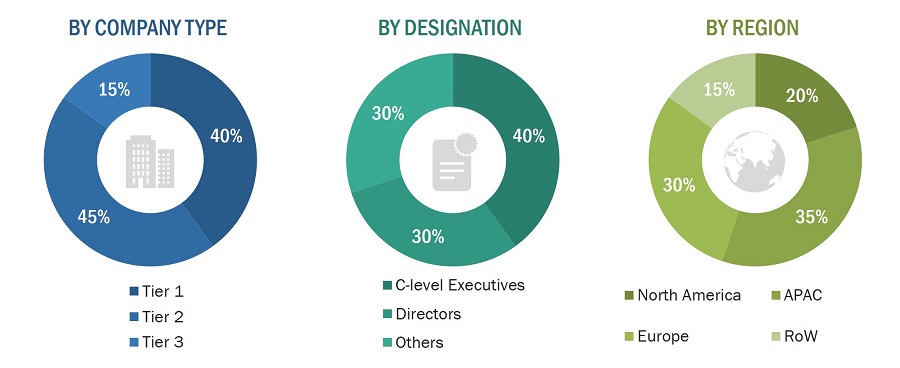
To know about the assumptions considered for the study, download the pdf brochure
Market Size Estimation
The top-down and bottom-up approaches have been used to estimate and validate the size of the vertical farming market and other dependent markets. Key players in the market have been identified through secondary research, and their market positions in the respective regions have been determined through primary and secondary research. This entire procedure includes studying the top players’ annual and financial reports and databases and extensive interviews with industry leaders such as CEOs, vice presidents, directors, and marketing executives for key insights.
All percentage share breakdowns have been determined using secondary sources and verified through primary sources. All the possible parameters that affect the markets covered in this research study have been accounted for, viewed in extensive detail, verified through primary research, and analyzed to get the final quantitative and qualitative data.
Vertical Farming Market: Bottom-Up Approach

Vertical Farming Market: Top-Down Approach

Data Triangulation
After arriving at the overall market size through the above process, the market has been split into several segments. The market breakdown and data triangulation procedures have been employed wherever applicable to complete the overall market engineering process and arrive at the exact statistics for all the segments. The data has been triangulated by studying various factors and trends from both the demand and supply sides. The market has also been validated using both top-down and bottom-up approaches.
Market Definition
Vertical farming is a method of cultivating crops on a vertical stack in an urban setup. In vertical farming, an artificial environment is created inside a facility, using technology, which helps plants grow with high nutritious content in a short period compared with traditional farming. Growth, productivity, and quality of plants depend on technologies such as climate control, air purification, lighting, and pump and irrigation systems. Vertical farming can be done using three different growth mechanisms: hydroponics, aeroponics, and aquaponics. Vertical farms can be of various types, such as building-based, shipping container-based, and deep farms. The output of the vertical farms is multi-fold compared with conventional farming in the same area of a farm, as crops are grown using vertical stacks in vertical farms in a controlled environment agriculture technology, increasing the quantity of produce. In contrast, in conventional farming, crops are planted at a single level, making vertical farming an efficient farming technique.
Key Stakeholders
- Raw material vendors
- Original technology designers and suppliers
- Raw material and component suppliers
- Vertical farming system manufacturers
- Assembly manufacturers
- System integrators
- Assembly and packaging vendors
- Technical universities
- Research institutes and organizations
- Market research and consulting firms
- Original equipment manufacturers (OEMs)
Report Objectives
The following are the primary objectives of the study.
- To define, describe, and forecast the vertical farming market by growth mechanism, structure, and offering, in terms of value.
- To define, describe, and forecast the vertical farming market by crop type, in terms of volume
- To forecast the market size, in terms of value, for various segments with regard to four main regions, namely, the North America, Europe, Asia-Pacific (APAC), and Rest of the World (RoW)
- To provide detailed information regarding the major factors influencing the growth of the market (drivers, restraints, opportunities, and industry-specific challenges)
- To understand and analyze the impact of evolving technologies on the overall value chain of the vertical farming market and upcoming trends in the ecosystem
- To highlight the impact of Porter's five forces on the vertical farming ecosystem and analyze the underlying market opportunities
- To analyze the associated use cases in the vertical farming business and their impact on the business strategies adopted by key players
- To provide key industry trends and associated important regulations impacting the global vertical farming market
- To strategically analyze the micromarkets with respect to the individual growth trends, future prospects, and contribution to the total market
- To analyze the opportunities in the market for stakeholders by identifying the high-growth segments of the global vertical farming market
- To forecast and compare the market size of pre-recession with that of the post-recession at global, and regional levels
- To strategically profile the key players and comprehensively analyze their market shares and core competencies, along with detailing the competitive landscape for the market leaders
- To analyze competitive developments such as joint ventures, mergers and acquisitions, new product developments, expansions, and research & development in the global vertical farming market
Available Customizations
With the given market data, MarketsandMarkets offers customizations according to a company’s specific needs. The following customization options are available for the report.
Company Information:
- Detailed analysis and profiling of additional market players (up to 5).




 Generating Response ...
Generating Response ...







Growth opportunities and latent adjacency in Vertical Farming Market
We want to establish a pilot project for vertical farming in Germany
I want to know the breakdown of the categories of the vertical farming market. So for instance, container farms, vertical greenhouses, instrument suppliers etc...
I am doing a report on vertical farming and believe this PDF would be a great asset in finding useful information.
UK protected edibles conventional producer, looking to enter VF as a primary producer. I am also applying for a Nuffield Scholarship to study VF in more detail so your report would be very useful. Thanks.